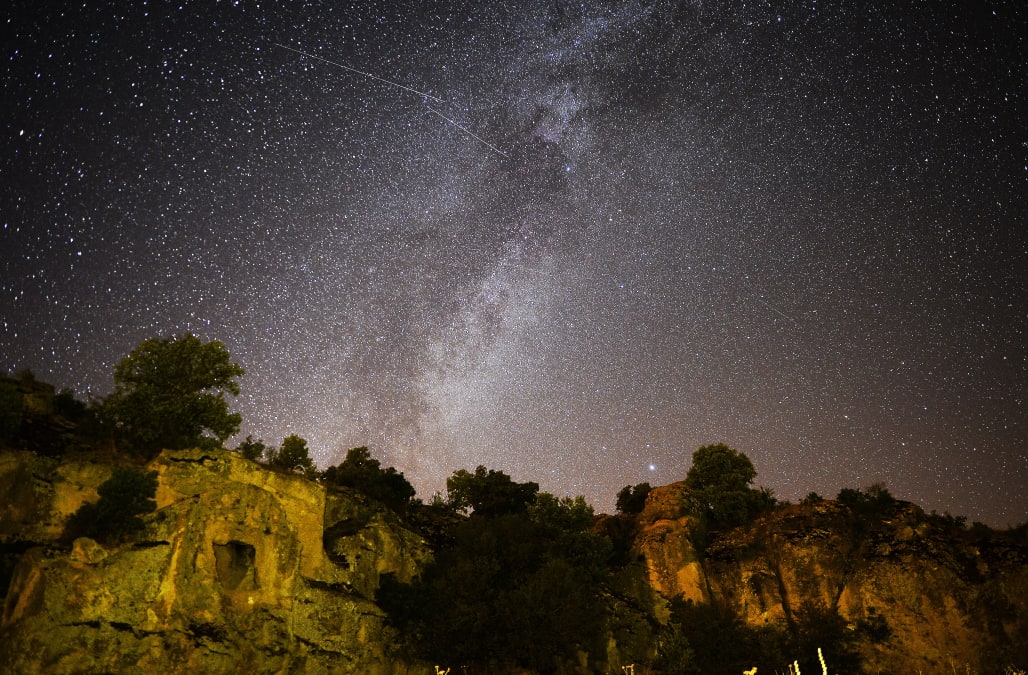
The wait is over and stargazers are gearing up for one of the top-rated meteor showers of the year, but clouds could disrupt the event for about one-third of the United States.
The Perseid meteor shower will peak on Tuesday night into early Wednesday morning, a reliable meteor shower that puts on a show year in and year out.
"The Perseids are the most popular meteor shower as they peak on warm August nights as seen from the northern hemisphere," the American Meteor Society (AMS) explained on its website.
This year, spectators can expect to see between 50 and 75 meteors an hour under dark skies, which averages out to about one meteor every minute.
"The Geminid meteor shower in December produces about the same number of meteors. Both showers produce about four times more than any other shower during the year typically does," AccuWeather Astronomy Blogger Dave Samuhel said.
One big difference between the Perseids and the Geminids is the weather. August typically features more comfortable stargazing weather for the Perseids compared to December's cold and often cloudy conditions around the peak of the Geminids.
As with every meteor shower, the best time to look is when the shower's radiant point is highest in the sky. The number of meteors able to be seen will gradually increase as the radiant point moves higher in the sky.
"They are called Perseids since the radiant (the area of the sky where the meteors seem to originate) is located near the prominent constellation of Perseus," the AMS explained.
Contrary to popular belief, skywatchers do not need to look at radiant point to see the meteor shower - - shooting stars will be visible streaking across all areas of the sky.
The radiant point for the Perseids will rise above the horizon by around 11 p.m. local time and will continue to climb higher in the sky as the night progresses. However, the moon is set to rise by around 1 a.m. local time and will bring with it natural light pollution, making it more difficult to see some of the fainter meteors.
Because of this, the best window for viewing this year's Perseid meteor shower will occur between 11 p.m. and 1 a.m. local time.
"Even though the Perseids will be most active after midnight, I encourage people to start looking once it gets dark in the evening," Samuhel said. "You will be more likely to see a long-lived, bright meteor fly across a large portion of the sky during the evening."
Onlookers staying out after 1 a.m. to watch the celestial light show should look to the darkest part of the sky away from the moon.
CLICK HERE FOR THE FREE ACCUWEATHER APP
This year, a majority of the western and central United States will have cloud-free conditions for the peak of the Perseids. Favorable weather is also in the forecast for much of western Canada and the Canadian Prairies.
Folks east of the Mississippi River may have some clouds to contend with, especially across the Ohio Valley to the coast of the mid-Atlantic.
Other areas, such as the Deep South, northern New England and into the St. Lawrence River Valley will have some breaks in the clouds which could provide opportunities to spot a few shooting stars throughout the night.
Meteors will continue to be visible in the nights following the peak, so those that find themselves under clouds on Tuesday night should plan for a night under the stars later in the week when weather conditions improve. However, the number of meteors visible will gradually decrease each night.
In addition to needing clear weather, a little patience is also required for watching the Perseids.
"Dedicate a solid hour to doing nothing but looking for meteors," Samuhel said. "If you only look for a few minutes, you might not see any."
It is important not to look at any source of light during while out looking for shooting stars, which includes cell phone screens.
"Make yourself comfortable. Lay back on a lounge chair, or a blanket on the grass. Don't sit in a normal chair and look up, you neck will quickly get tired," Samuhel said.
After the Perseids pass, the next moderate meteor shower will not occur until mid-October with the peak of the Orionids.
Keep checking back on AccuWeather.com and stay tuned to the AccuWeather Network on DirecTV, Frontier and Verizon Fios.
"popular" - Google News
August 09, 2020 at 06:08PM
https://ift.tt/3krlGUb
Tuesday night to feature the "most popular meteor shower" of 2020 - AOL
"popular" - Google News
https://ift.tt/33ETcgo
Shoes Man Tutorial
Pos News Update
Meme Update
Korean Entertainment News
Japan News Update
Bagikan Berita Ini















0 Response to "Tuesday night to feature the "most popular meteor shower" of 2020 - AOL"
Posting Komentar